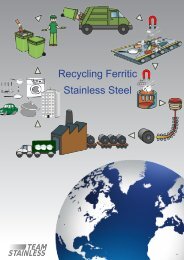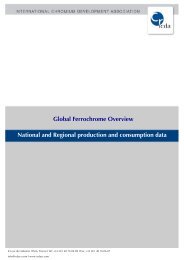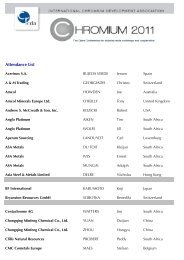Ore Processing - ICDA
Ore Processing - ICDA
Ore Processing - ICDA
You also want an ePaper? Increase the reach of your titles
YUMPU automatically turns print PDFs into web optimized ePapers that Google loves.
Discover Chromium<br />
<strong>Ore</strong> <strong>Processing</strong><br />
The following diagram illustrates a typical material flow:<br />
Chrome ore in various sizes is typically charged into a submerged AC Electric Arc Furnace and<br />
reductants (coke, coal and quartzite ) are added. The smelting process is energy intensive requiring upt<br />
to 4,000 kWh per tonne material weight. Slag is separated from the liquid ferrochrome and tapped into<br />
ladles for further processing. Liquid ferrochrome is then poured into moulds and after cooling crushed<br />
into sizes as required by the customers. Crushed ferrochrome is railed to final customers or harbours for<br />
shipment.<br />
<strong>Ore</strong> <strong>Processing</strong><br />
International Chromium Development Association - ©2011<br />
www.icdacr.com
Initial processing of chromite ores can be by hand<br />
sorting of lumpy ores, and by heavy media or<br />
gravity separation of finer ores, to remove gangue<br />
or waste materials and produce upgraded ores or<br />
concentrates. Magnetic separation and froth<br />
flotation techniques have also been applied in<br />
some cases.<br />
Most of the world's production of chromite (95%)<br />
is used in the metallurgical industry in the form of<br />
ferrochromium alloys. The alloys are produced by<br />
high temperature reduction (smelting) of chromite.<br />
They are essentially alloys of iron and chromium<br />
with much lesser amounts of carbon and silicon, the amounts depending upon the grade or type of<br />
alloy, and impurities such as sulphur, phosphorous and titanium. The conversion of chromite to<br />
ferrochromium alloys is dominated by electric submerged arc furnace smelting with carbonaceous<br />
reductants, predominantly coke, and fluxes to form the correct slag composition. The electric current is<br />
3-phase Alternating Current (AC) and the furnaces have three equally spaced consumable graphite<br />
electrodes in a cylindrical, refractory-lined container with a bottom tap-hole.<br />
Characteristics of the submerged arc furnace for smelting chromite include:<br />
1. Relatively easy to control provided the charge is well sorted to maintain a permeable overburden<br />
which will allow easy escape of the gases produced.<br />
2. Self-regulating with power input determining the rate of consumption of charge (overburden)<br />
3. Some pre-heating and pre- reduction of the overburden by the hot ascending gases.<br />
Submerged arc furnaces can be open, semi-closed or closed with correspondingly better thermal<br />
efficiency and the ability to make use of the energy in the off-gases from the closed furnaces.<br />
In the early days of high-carbon ferrochromium production, the furnaces were supplied with highgrade,<br />
lumpy chromite from countries such as Zimbabwe but with the increasing demand from the<br />
1970s, other countries, South Africa in particular, commenced production from their lower-grade ores.<br />
The alloy produced from these ores became known as charge chrome because the chromium content<br />
was lower and the carbon content, and in particular the ratio of C:Cr, was very much greater than in<br />
high-carbon ferrochromium. This did not suit the stainless steelmakers who required as little carbon as<br />
possible entering their melts for each chromium unit and who were, therefore, having to use larger<br />
amounts of the more costly low-carbon ferrochromium to compensate. However, the situation changed<br />
radically with the advent of the argon-oxygen decarburising (AOD) and vacuum-oxygen decarburising<br />
(VOD) processes. These processes enabled the steelmakers to remove carbon from the stainless melts<br />
without excessive oxidation and losses of chromium.<br />
A more advanced attempt to overcome the problem of ore fines was the introduction of DC arc, or<br />
plasma, furnace technology. The DC arc furnace uses a single, central hollow graphite electrode as the<br />
cathode, with an electrically conducting refractory furnace hearth as the anode. The furnace operates<br />
with an open bath, so there is no problem with overburden, and the chromite fines, together with coal<br />
and fluxes, are fed directly into the bath through the hollow electrode. The furnace has a closed top.<br />
Some of the advantages of DC arc furnace operation are: use of fine ores without agglomeration, use of<br />
cheaper reductants and greater choice of reductants, higher chromium recoveries, deliberate changes in<br />
<strong>Ore</strong> <strong>Processing</strong><br />
International Chromium Development Association - ©2011<br />
www.icdacr.com
the charge composition are reflected rapidly in the slag or metal, and closed top operation allows<br />
furnace off-gas energy to be used.<br />
Another approach to friable ores has been to pelletise them, after further grinding if necessary, with<br />
binder, reductant and fluxes and pass them through a rotary kiln where they are hardened (sintered),<br />
pre-heated and pre-reduced to a degree before charging to a submerged arc furnace.<br />
A further development in treating ore fines by kiln pre-reduction used unaglomerated chromite fines<br />
and low cost coal, with fluxes, as the feed to the kiln. Self agglomeration of the fines was achieved close<br />
to the discharge from the kiln where the charge becomes pasty in a high temperature zone of approx.<br />
1,500ºC. Very high degrees of reduction were achieved (80-90%) so that the downstream electric<br />
furnace (DC arc) became essentially a melting furnace.<br />
A more recent approach, and one which is being installed by more plants, is again by pelletising. Pellets<br />
are produced with coke included and these are sintered and partly pre-reduced on a steel belt sintering<br />
system. From there, the pellets are delivered to pre-heating shaft kilns that are sited above submerged<br />
arc furnaces and which operate as direct feed bins, making use of the off-gas heat from the furnaces.<br />
Lump ore, coke and fluxes are also directed to the feed bins.<br />
In addition to the technologies already discussed,<br />
there have been various other approaches to<br />
smelting chromite. These include rotary hearth<br />
sintering and pre-reduction of pellets, and fluidised<br />
bed pre-heaters for chromite fines.<br />
Some intensive development work has been carried<br />
out in Japan upon entirely coal/oxygen based<br />
smelting processes using no electrical energy,<br />
sometimes referred to as smelt-reduction processes.<br />
<strong>Ore</strong> <strong>Processing</strong><br />
International Chromium Development Association - ©2011<br />
www.icdacr.com
















